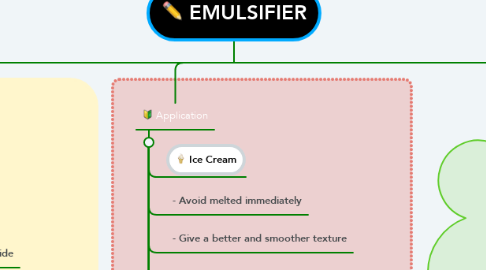
1. Definition and structure of emulsifier
1.1. Definition
1.1.1. -Also called emulgent
1.2. - A surface-active agent that acts as a border between two immiscible liquids such as oil and water, allowing them to be blended into stable emulsions.
1.3. Structure
1.4. Hydrophilic head- Align towards water phase
1.5. Lipophilic tail- Align towards lipid phase
2. Example of emulsifier
2.1. Mono- and diglyceride
2.2. Hydrocolloid emulsifier
2.3. - Locust bean gum (LBG)
2.4. - Xanthan gum
2.5. - Gum arabic
2.6. Diacetyl Tartaric Acid Esters of Monoglycerides (DATEM)
2.7. - Act as a dough conditioner.
2.8. Polyglycerol Esters of Fatty Acids (PGE)
2.9. Lecithin
2.10. - Egg yolk, soy bean
2.11. Citric acid ester
2.12. - Commonly used for margarine, coffee whitener, cream
3. Type of emulsion
3.1. Water in oil emulsion
3.2. - Oil is continuous phase, while water is dispersed phase
3.3. - Butter, margarine, spread
3.4. Oil in water emulsion
3.5. - Oil is dispersed phase, while water is continuous phase
3.6. - Milk, cream, mayonnaise, cake batter
4. Hydrophile-lipophile balance (HLB)
4.1. - Represents the oil and water solubility of an emulsifier and is used to classify emulsifiers
4.2. - Ratio of weight percentage of hydrophobic and hydrophilic group
4.3. - Values are affected by temperature
4.4. - Range 0 to 20
4.5. HLB less than 9
4.6. - Lipophilic
4.7. - More oil soluble
4.8. HLB more than 10
4.9. - Hydrophilic
4.10. - More water soluble
4.11. - Example: Hydrophilic sugar esters
4.12. HLB 8 to 11
4.13. - Intermediate
5. Application
5.1. Ice Cream
5.2. - Avoid melted immediately
5.3. - Give a better and smoother texture
5.4. - Emulsifier used: Lecithin, mono-diglycerides, polysorbates
5.5. Margarine
5.6. - Enhancement of spreading effects of oils and fat
5.7. -Improvement of foaming and air-holding abilities and creaminess
5.8. - Prevention of spattering during cooking
5.9. - Emulsifier used: Citric acid esters of mono- and diglycerides
5.10. Tofu
5.11. - Makes a complex with starch which inhibits swelling
5.12. - Increase protein content in the soybean milk.
5.13. - Emulsifier used: monoglyceride
5.14. Instant Mashed Potatoes, Noodle
5.15. - Amylose in the starch granule dissolve, causes sticky product.
5.16. - Forms a starch complex, which protects starch granules.
5.17. - Emulsifier used: monoglyceride
5.18. Chocolate
5.19. - Inhibit crystal growth
5.20. - Avoid fat bloom rapidly
5.21. - Emulsifier used: Sorbitan tristearate
5.22. Bread
5.23. - Increase the dough resistance to mechanical force to soften
5.24. - Maintain the softness
5.25. - Increase shelf life of bread
5.26. - Emulsifier used: mono-diglycerides of fatty acids, Diacetyl tartaric acid esters
6. Classification
6.1. Non Ionic
6.2. - No ionization in water
6.2.1. - Example: monoglyceride
6.2.1.1. - Mostly used in food products
6.3. - For molecule that is not sensitive to pH & salt level in food.
6.4. Cationic
6.5. - Cannot act as food preservative
6.6. -Used in acidic or neutral condition
6.7. Anionic
6.8. - Used in alkaline or neutral condition
6.9. - Negative charged
6.10. - Sensitive to pH level and ionic strength of molecule
6.11. - Example: Stearoyl lactylate
7. Function
7.1. Modifying texture, shelf life of food
7.1.1. - Complexing starch and protein component.
7.1.2. - Example: mashed potato, baked good, pasta, rice
7.1.3. Control gas-in-liquid dispersion
7.1.4. - Example: Topping, cake
7.1.5. Modifying ability of fats and oils
7.1.6. - Crystal modification Increase the food (fat- based) texture by controlling the polymorphism of fats (Coating)
7.1.7. - Positive charged
7.1.8. Has the ability to hold water
7.1.9. Able to decrease the stickiness of food
7.1.10. - Such as Candy, Chewing gums
7.1.11. Wetting
7.1.12. - Liquid able to spread evenly
7.1.13. - Example: Powdered food, Coffee whitener
7.1.14. Inhibit the crystal growth
7.1.15. - Prevent from blooming
7.1.16. Improve the Plasticity of Fats and Oils
7.1.17. - The formation of these abundant crystals of solid fat. - Example: Margarine
